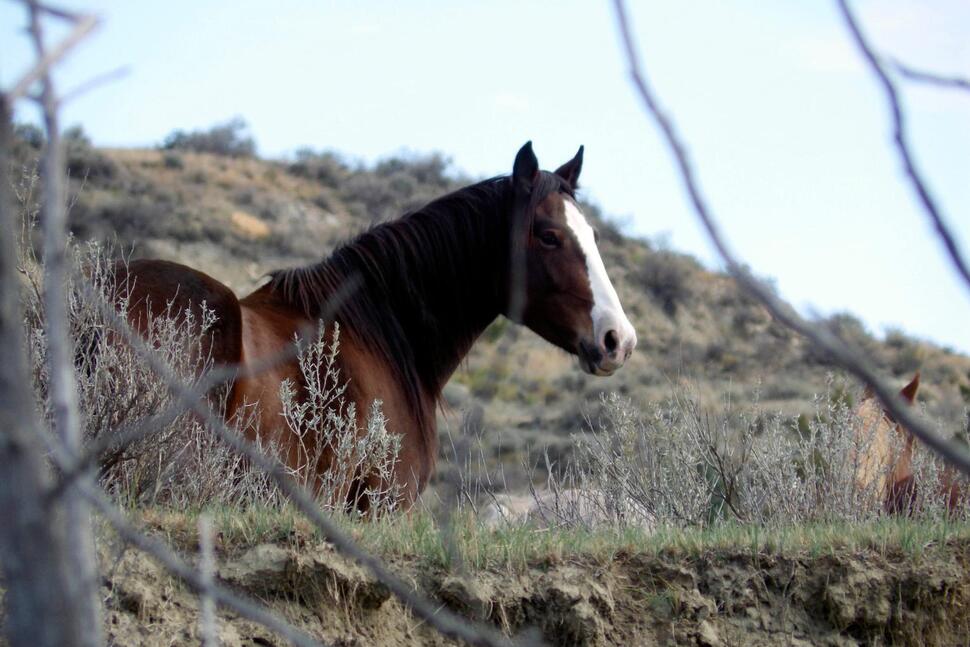In the sprawling landscapes of western North Dakota, approximately 200 untamed horses gracefully traverse a national park, their hooves echoing through the pristine wilderness. 🐴🌿
BISMARCK, N.D. (AP) — In the heart of a western North Dakota national park, a herd of around 200 wild horses paints a picturesque scene against the backdrop of nature’s canvas. However, the future of these majestic creatures hangs in the delicate balance of a critical decision looming next year from the National Park Service—one that could potentially erase this unique population.
Concerns ripple through the advocate community over a predetermined outcome that might displace these cherished animals from their home in Theodore Roosevelt National Park. The ongoing public comment period, set to conclude this Friday, revolves around a recent environmental assessment offering three proposals: swiftly reducing the horse population, gradually decreasing it, or taking no immediate action.
In this unfolding drama, the horses find stalwart allies in North Dakota Gov. Doug Burgum and U.S. Sen. John Hoeven. Advocates mobilize every resource to ensure the continued presence of these horses, while park officials actively seek public input.
Adored by park visitors, these horses embody a natural elegance as they grace the scenic roads and hiking trails in the rugged Badlands, often becoming the subjects of captivating photographs.
The impending decision on the horses’ fate aligns with a long-awaited evaluation, reflecting a commitment to overarching policies. This includes the removal of non-native species from parks if they pose potential risks to resources, as explained by Jenny Powers, a wildlife veterinarian leading the National Park Service’s wildlife health program.
“This isn’t an easy decision for us, but it is one that is directly called for by our mission and mandates,” Powers shared with The Associated Press last month.
A primary advocate for the horses, Chris Kman, President of Chasing Horses Wild Horse Advocates, expresses deep concerns that park officials might have already decided to remove the horses. Kman highlights several options for retaining the horses that were seemingly dismissed in the recent environmental assessment.
In the official document, the Park Service stated that these alternatives wouldn’t be “in alignment with NPS priorities to maintain the native prairie ecosystem” and wouldn’t sufficiently address the animals’ impacts.
Despite expressing optimism, Kman notes, “I believe we will ultimately prevail in this battle. However, I lack confidence that the park will make the right decision to keep the horses in the park.”
Even if the horses are permitted to stay, Park Superintendent Angie Richman suggests a reduction to a range of 35-60 animals, following a 1978 environmental assessment. This ongoing process is part of the park’s proposed management plan for “livestock,” a term strongly rejected by the horses’ advocates.
Originally enclosed in the park by accident, wild horses became a historic demonstration herd, preserved against persistent eradication efforts, according to Castle McLaughlin, who delved into the horses’ history in the 1980s as a graduate student working for the Park Service in North Dakota.
Advocates for wild horses advocate for a more comprehensive environmental review, striving for the establishment and maintenance of a genetically viable herd comprising at least 150 horses.
Despite the majority of previous public comments opposing the removal of the horses, Grace Kuhn, communications director for the American Wild Horse Campaign, finds it “challenging to comprehend why the government would choose to take them away from the American people.”
Asserting that the wild horses “have a rightful place in the national park,” Kuhn emphasizes that their presence aligns with Roosevelt’s vision to preserve cultural resources for future generations.
“Essentially, the Park Service by implementing a plan to either eradicate them quickly or eradicate them slowly, they’re thumbing their noses at the American public and their mission,” Kuhn said last month.
In January, Governor Burgum extended a collaborative offer for state involvement in preserving the horses within the park. Discussions between his office and park officials have explored various options. North Dakota is open to considering state management or assistance in managing the horses within the park; however, relocation is not on the table, clarified Mike Nowatzki, spokesperson for the governor’s office on Monday.
Park Superintendent Richman stated last month, “We are certainly willing to work with the governor and the state to find a positive outcome,” noting ongoing collaboration on “a lot of different options.” She emphasized that it would be premature to disclose discussions still in progress at this time, as of Wednesday.
Senator Hoeven has been engaged in negotiations with park officials and has introduced legislation in the U.S. Interior Department’s appropriations bill to safeguard the horses. In the event that this proves insufficient, he expressed willingness to pursue additional legislation. Hoeven emphasized, “My goal is to maintain the presence of horses in the park.”
The final decision by the park will also impact nine longhorn cattle in the North Unit of the park, while all the horses are currently situated in the South Unit.
